A 5-day camping road trip in Scotland
There’s a lot to see in Scotland, especially if you’re into the outdoors. Covering a third of the UK’s landmass and home to ancient forests, breathtaking mountains and thousands of lochs, the variety of the country and its sheer scale can be a bit daunting for first-time visitors trying to plan an itinerary.
Our ultimate five-day Scotland road trip is a whistle-stop tour of some of the country’s most scenic and intriguing spots. We’ve tried to fit in some of the Scottish mainland’s top attractions and most spectacular scenery, but there’ll be plenty of places along the way where you can appreciate the peace, quiet and slower way of life of the Scottish countryside.

Camping in Scotland
Camping is one of the best ways to take in Scotland’s gorgeous scenery, whether you're in a caravan, a motorhome or a tent. The country is awash with top-rated campsites and there’s scope for wild camping, as well as glamping for those that want to get close to nature without sacrificing home comforts. We’ve hand-picked some of our favourite places to camp and glamp along the route, but there are lots more options to choose from – just click the button under each day’s itinerary for a full run-down of what’s available. Opting to camp also makes it much easier to bring your dog than staying in hotels or bed and breakfasts.
Scottish campsites can quickly run out of availability, especially in the high season, so it’s recommended that you book your pitch in advance once you’ve decided on your dates to get the best deals and most scenic sites.
Our five-day Scotland road trip
Day 1: Edinburgh or Glasgow to Loch Lomond
From the Central Belt to the edge of the Highlands
Distance: 90 miles (from Edinburgh)
45 miles (from Glasgow)
Driving time: two hours (from Edinburgh)
one hour (from Glasgow)
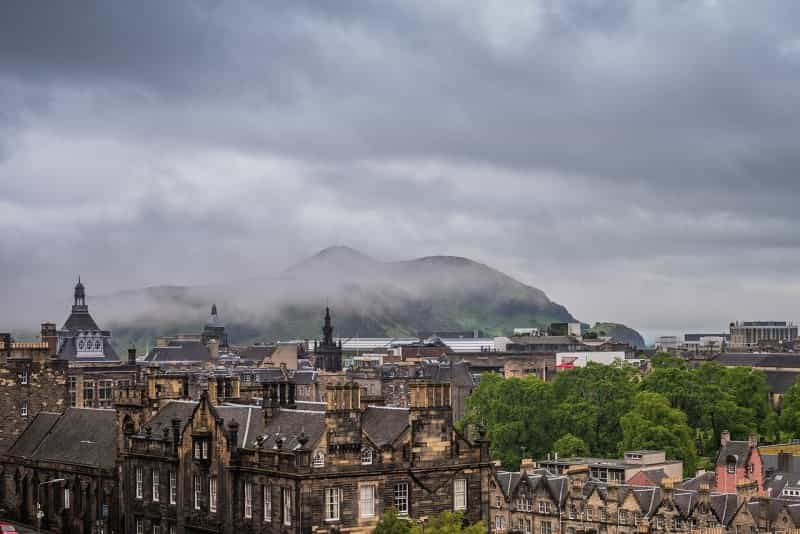
We’ve designed a circular road trip that can be started/finished in either Glasgow or Edinburgh, both of which have excellent nearby campsites for city breaks.
Glasgow is great for shopping and exploring Victorian architecture, and has a range of fantastic free museums, while Edinburgh is visibly older, smaller and easier to get around on foot (although the downside is that it can feel more ‘touristy’). Both are excellent cities to visit in their own right and are only an hour apart, so if you have a day to spare at the start or end of this trip it’s well worth exploring whichever place you didn’t start from.
This relatively short drive takes you from the city to the countryside and up the western side of Loch Lomond, Scotland’s biggest freshwater body of water. Settle down for the evening in the pretty village of Inveruglas at Loch Lomond Holiday Park, a friendly and well-maintained campsite just a short stroll from the water’s edge. Get up early in the morning, make a flask of coffee and head down to the edge of the loch to watch the sunrise for an extra-special start to your day.
Top tips for day 1:
If you’re coming from Edinburgh, take the M9 to drive past The Kelpies, a spectacular pair of horse head sculptures that are well worth the five-minute detour to see. If you’re coming from Glasgow and looking for somewhere for lunch, stop in the lochside village of Luss en route for fish and chips.
Day 2: Loch Lomond to Fort William
From Scotland’s largest loch to its highest mountain
Distance: 65 miles
Driving time: an hour and a half

This section covers the northern side of Loch Lomond National Park and the spectacular valley of Glencoe, which makes an excellent stop-off point for lunch and a walk. After learning about the tragedy of the Glencoe massacre, drive over the iconic road bridge in Ballachulish and enter the Great Glen, a huge geological fault that diagonally slices mainland Scotland in two. Continue up the shores of Loch Linnhe on the coast and finish your journey in Fort William in the shadow of Ben Nevis, the UK’s highest mountain.
Book a pitch at Ben Nevis Holiday Park or Linnhe Lochside Holidays, both spacious sites that are just a few miles from the town centre, yet have spectacular views over the local landscape. Fort William is known as the outdoor capital of Scotland, so by camping you’ll be well placed to appreciate all it has to offer.
Top tips for day 2:
There are lots of viewpoints worth stopping at between Bridge of Orchy (40 minutes) and Glencoe (an hour and five minutes), with views over lochs, geological formations and Rannoch Moor.
If you fancy climbing Ben Nevis, earmark a full day, set off early and check the forecast beforehand.
If you’re here in the summer and want a quick dip in the sea, there’s a small beach at Cuil Bay – add half an hour’s driving time to get there and back.
Day 3: Fort William to Inverness
Through the Great Glen to the North Sea
Distance: 65 miles
Driving time: an hour and 45 minutes

After waking up and cooking breakfast on site (or heading into Fort William for a traditional full Scottish), start off the day with a gentle forest walk in Lower Glen Nevis, or head a couple of miles out of Fort William to admire Neptune’s Staircase, a series of eight locks on the Caledonian Canal. Next, set off up the Great Glen, passing through the pretty village of Fort Augustus at the southern end of Loch Ness, where there are several places to stop for lunch.
Stop off for another hour or so at Drumnadrochit to see lochside Urquhart Castle before continuing north to the outskirts of Inverness, the only city in the Highlands. There’s a range of campsites suitable for overnight stops around Inverness – for glamping accommodation, check out Camping Pod Heaven, or alternatively continue to the coastal town of Nairn for a stay among the sand dunes at Nairn Lochloy Holiday Park.
Top tips for day 3:
Spend an extra day near Nairn and Inverness to visit the nearby Culloden Battlefield, the scene of the last pitched battle on British soil. You might also like to use your extra time to take a dolphin-spotting cruise on the Moray Firth or to explore Inverness Botanic Gardens, a hidden gem on the southern edge of the city.
Day 4: Inverness to Perthshire
Back to the Lowlands via the Cairngorms National Park
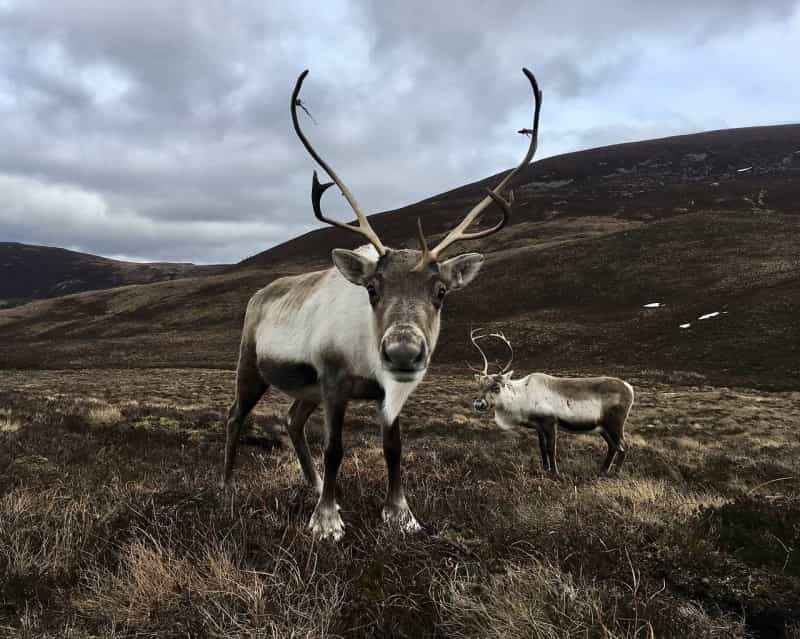
Distance: 120 miles
Driving time: Two hours and 30 minutes
After exploring the city of Inverness, take the A9 south through the Cairngorms National Park, home to some of the most spectacular landscapes in this part of Scotland. Stop off in Aviemore to see the herd of reindeer that live on Cairngorm mountain or take a forest walk around the Rothiemurchus Estate before continuing southwards towards Perthshire.
You could stop for the night pretty much anywhere around Perthshire, as this county is great camping territory. Braidhaugh Holiday Park near Crieff scores highly with its central location and top-notch facilities – it’s even possible to book accommodation with a hot tub if you want something special for your last night on the road.
Top tips for day 4:
This is by far the longest day of driving, so take it slow and make lots of stops. In addition to Aviemore, Pitlochry has plenty of choices for lunch; further down on the edge of the Lowlands the ancient cathedral at Dunkeld is also well worth calling in to see.
Day 5: Perthshire to Glasgow or Edinburgh
Must-see Scottish landmarks on the home straight
Distance: 50 miles (to Glasgow)
65 miles (to Edinburgh)
Driving time: An hour and 10 minutes (to Glasgow)
An hour and 35 minutes (to Edinburgh)
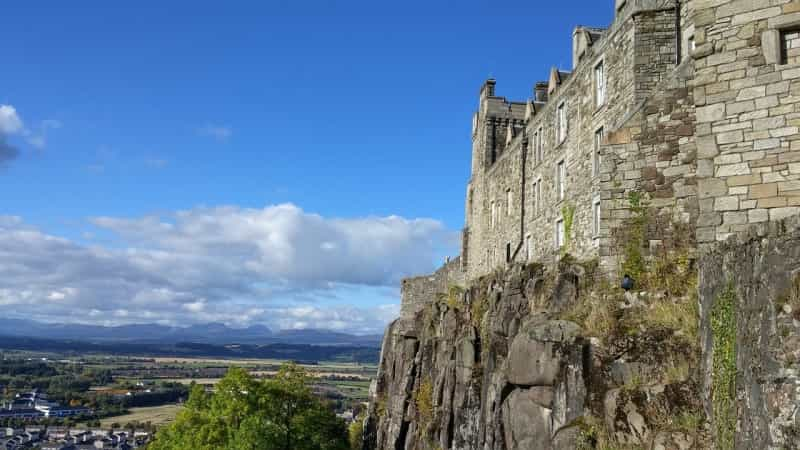
Our final day’s itinerary is a bit of a wild card. Whether you’re returning to Glasgow or Edinburgh, around 40 minutes after leaving Crieff you’ll reach Stirling Castle, one of the most impressive buildings in Scotland with a rich history, exceptional architecture and far-reaching views.
If you’re heading to Edinburgh and are still enjoying the drive, we recommend stopping off at the Falkirk Wheel, a huge rotating boat lift with a visitor centre connecting two of central Scotland’s most important canals. You can then see another impressive feat of engineering with a quick stop in South Queensferry, home to the iconic Forth Rail Bridge, a UNESCO World Heritage Site. These stops will add roughly half an hour to the day’s driving.
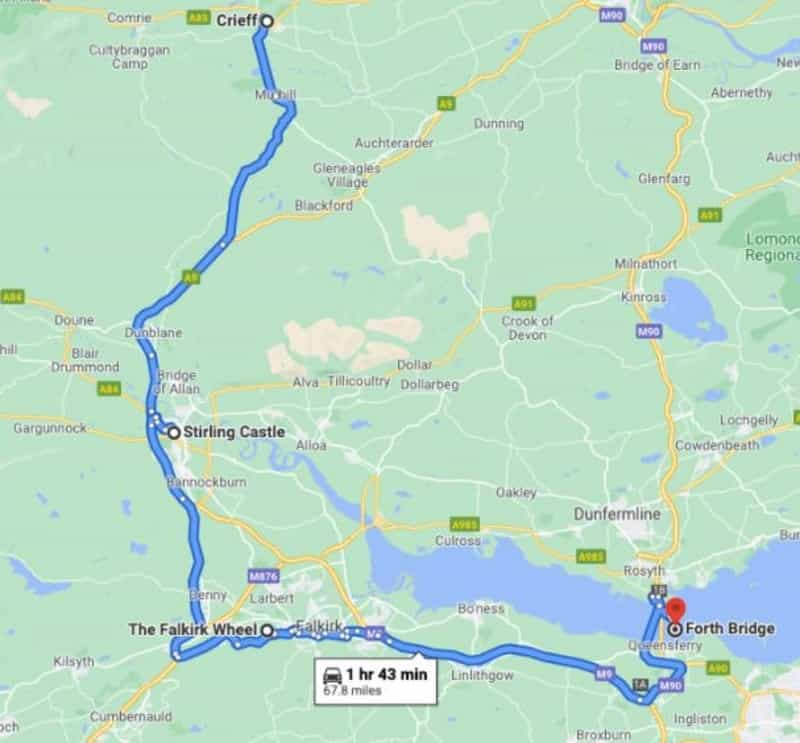
Another alternative route is available for travellers returning to Glasgow, but it does add an extra hour to your driving time and means that you’ll have to save Stirling Castle for another day. Heading out of Crieff, drive along the side of Loch Earn and south through the Trossachs, a spectacular range of hills and wooded glens. Stop for a boat ride on the vintage steamship at Loch Katrine, take a hike up gorgeous Ben Venue, or head to Queen Elizabeth Forest Park near Aberfoyle to spot red squirrels in the undergrowth.
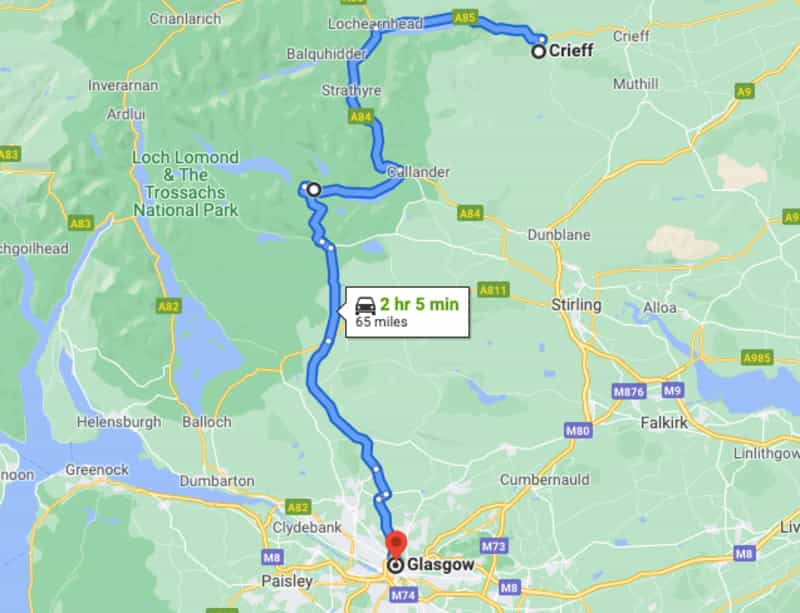
Scotland road trip FAQs
How many days does it take to see Scotland?
Scotland is a small country but there’s lots to see, including many remote areas. We recommend at least five days if you’re planning a road trip in Scotland.
What can I see in Scotland in five days?
A five-day road trip in Scotland is enough to give you a flavour of one or two of the country’s largest cities as well as its biggest and deepest lochs, and introduce you to both of the country’s national parks. There are also lots of castles that you can see along the way, and you’ll catch sight of both the east and west coasts. View our recommended 5 day itinerary.
Can you camp anywhere in Scotland?
Under the Scottish Outdoor Access Code, wild camping in tents is permitted almost anywhere in Scotland. However, there are no such access rights for your vehicle (although in practice it should be possible to find a stopping place where overnight parking is tolerated). There are also seasonal restrictions on wild camping in place in Loch Lomond and the Trossachs National Park. Nearly wild campsites make a great alternative – explore the options here.
How do I plan a road trip in Scotland?
Scotland has lots to see, so planning your own itinerary can seem a bit daunting. You can either use this five-day plan or plan your own route. If you opt for the latter, make sure you are realistic about how much driving you will want to do in one day. If you are driving in remote areas, we also recommend that you make a note of places where you can refuel or recharge your vehicle, as these can be few and far between the further north you go.
How far can I drive in five days in Scotland?
We recommend planning time on your drive to stop and experience what Scotland has to offer. Our five-day itinerary involves roughly 400 miles of driving, depending on the route you take.
What cities can I include on a Scottish road trip?
Depending on your chosen route – all of them. Our recommended 5-day itinerary starts in Edinburgh or Glasgow and you will also see the historic cities of Inverness and Stirling.
What is the Scottish landscape like?
Scotland’s landscape is incredibly diverse, and this road trip takes in some of the prettiest parts of the Highlands and the Lowlands, as well as both of the country’s national parks. While mostly inland, the route does include two coastal locations, but if you are looking for lots of beaches you might like to check out the North Coast 500 and South West Coast 300 instead.
Do I have time to see any islands on a five-day Scottish road trip?
Not with our route, although if you have a couple of extra days to spare, on day two you could easily head to Oban instead of Fort William and catch ferry services to Kerrera, Mull, Iona and other Hebridean islands.